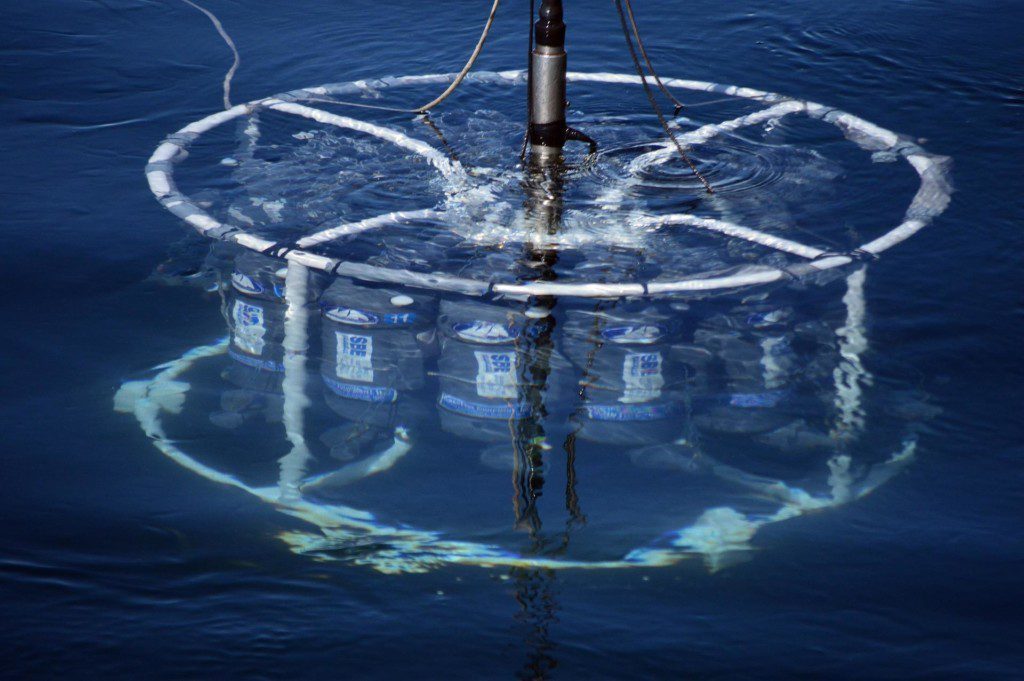To effectively ensure that fish and other organisms in the ocean remain healthy, there are a variety of measurements that must be maintained. One of these measurements has to do with water conductivity, which refers to the degree in which water is able to conduct electricity. The conductivity of electricity in water is identified by how well electricity can pass through the water. If ever you attempt to pass electricity through pure water, it won’t be able to do so since pure water has practically zero ions in it. The presence of high amounts of ions allows for greater water conductivity.
The conductive ions that get into water come from numerous sources, which include chlorides, dissolved salts, carbonate compounds, sulfides, and alkalis. Distilled water or water that has been de-ionized can potentially exist as an insulator because of the low conductivity value that it has. A type of water that comes with some of the highest conductivity values is sea water, which has a high conductivity because of how much salt can be found in the water.
Along with the health of ocean water, conductivity also plays a role in salinity, which is the overall saltiness of a body of water. Salinity measurements aim to identify how much dissolved salts are situated in water. Electrolytes are able to form ionic particles when they dissolve, which creates a negative and positive charge. Salinity is very difficult to directly measure for, which is why conductivity measurements are taken to determine what the salinity is of the water in question. The many different kinds of dissolve salts that can cause the salinity of water to increase include carbonates, calcium, sodium, and magnesium.
To better understand how water conductivity works, you should also be aware of how temperature relates to conductivity. An increase in water temperature leads to an increase in water conductivity. It’s possible for conductivity values to increase by as much as 2-4 percent for every one-degree Celsius increase in water temperature. An increase in water temperature also causes an increase in ionic mobility, which is why conductivity will typically be at its highest in the middle of the day.
This article offers a comprehensive guide on how important water conductivity is.
Why is Water Conductivity Important?
 Water conductivity is important for a number of different reasons. In fact, it’s among the most common measurements taken when attempting to determine the quality of water. Conductivity measurements are typically used to make calculations for total dissolved solids as well as salinity in the water. In many bodies of water, conductivity measurements are taken on a consistent basis to make sure that the water quality remains high and that the plants and animals in the water don’t suffer. When conductivity measurements are taken regularly, the readings should remain fairly consistent. However, it’s possible for these readings to change substantially after high amounts of pollution get into the water, evaporation occurs, or natural flooding takes place. These events can be very harmful to the overall water quality.
Water conductivity is important for a number of different reasons. In fact, it’s among the most common measurements taken when attempting to determine the quality of water. Conductivity measurements are typically used to make calculations for total dissolved solids as well as salinity in the water. In many bodies of water, conductivity measurements are taken on a consistent basis to make sure that the water quality remains high and that the plants and animals in the water don’t suffer. When conductivity measurements are taken regularly, the readings should remain fairly consistent. However, it’s possible for these readings to change substantially after high amounts of pollution get into the water, evaporation occurs, or natural flooding takes place. These events can be very harmful to the overall water quality.
Conductivity and salinity are typically used hand-in-hand because of how well they correlate with one another. Since conductivity is considerably easier to measure on its own, these readings are used to identify total dissolved solid amounts and salinity concentrations in the water, both of which play a part in the quality of the water as well as aquatic life. Salinity is critical to water quality since it affects the solubility of dissolved oxygen.
Higher salinity levels equate to lower dissolved oxygen levels, which can be problematic for some aquatic life. While it’s possible for some organisms to thrive in water that has high salinity levels, most organisms will either experience death or a significant reduction in health. High salinity is also bad for drinking water and can be expensive to treat. The three separate factors that affect water conductivity include the types of ions in the water, the total concentration of ions in the water, and the temperature of the water.
Conductivity Technology
 When you want to measure the conductivity of water, it’s important that you use the right pieces of technology. Water conductivity can be effectively measured with an electric probe and data logger, the latter of which captures the readings that are obtained from the probe. These same measurements will allow you to determine the salinity of water. The probe will directly measure how much of an electrical current is able to move through the water. The value that you receive will give you the ability to calculate total salinity.
When you want to measure the conductivity of water, it’s important that you use the right pieces of technology. Water conductivity can be effectively measured with an electric probe and data logger, the latter of which captures the readings that are obtained from the probe. These same measurements will allow you to determine the salinity of water. The probe will directly measure how much of an electrical current is able to move through the water. The value that you receive will give you the ability to calculate total salinity.
Conductivity can be determined by looking at how well an electrical current is able to flow between two separate metallic plates. The metal plates are referred to as electrodes. Any dissolved salts that are located in the water will start moving towards the plate that holds the opposite charge. The majority of probes that are used for the measurement of water conductivity are comprised of cells with four electrodes. While two of the electrodes measure the water current, the additional two electrodes focus on maintaining a constant current.
As for salinity, likely the best technique that can be used to calculate and determine salinity is to conduct a chemical analysis to identify the concentrations of various ions that can be found in the water, which include everything from calcium and chloride to carbonate and sodium. While a chemical analysis is highly effective at determining salinity, it’s also cost-prohibitive and time-consuming. To avoid these issues, it’s recommended that you calculate salinity via your conductivity measurements.
Since the salts that are present in the water are able to conduct current, the conductivity measurements will be very similar to the overall salt concentration or salinity. The data logger that you use to assist with your water conductivity measurements uses a difficult-to-understand mathematical equation to convert conductivity measurements into salinity estimations. This equation is relatively accurate since it accounts for temperature when making the conversion.
As touched upon previously, ions are electrically charged particles that form when salts and certain inorganic chemicals start dissolving in the water. These particles directly enhance the ability of the water to conduct electricity, which means that high levels of ions indicate high conductivity levels. The main ions that are found in water include:
- Sodium
- Chloride
- Calcium
- Magnesium
Conductivity and Water Flow
 When looking at water conductivity, it’s important to understand how water flow factors into the conductivity of water. If the water inflow comes from a freshwater source, conductivity values and salinity levels will decrease. The primary freshwater sources include clean streams, springs, and fresh groundwater. As for groundwater that already consists of high amounts of minerals, any groundwater inflows will automatically lead to an increase in conductivity values and salinity levels. Groundwater inflows typically come from agricultural runoffs. The amount of change that occurs with the conductivity and salinity of water depends on the flow rate from the freshwater or groundwater source.
When looking at water conductivity, it’s important to understand how water flow factors into the conductivity of water. If the water inflow comes from a freshwater source, conductivity values and salinity levels will decrease. The primary freshwater sources include clean streams, springs, and fresh groundwater. As for groundwater that already consists of high amounts of minerals, any groundwater inflows will automatically lead to an increase in conductivity values and salinity levels. Groundwater inflows typically come from agricultural runoffs. The amount of change that occurs with the conductivity and salinity of water depends on the flow rate from the freshwater or groundwater source.
Rain can also affect water flow by introducing very high conductivity values to the water. As it falls to the ground, rain will take in dust particles and gases, which causes the conductivity of rain to increase. However, heavy amounts of rainfall may lead to a reduction in conductivity values since the salinity concentration of the body of water it falls into will be diluted. Keep in mind that the conductivity effects of rainfall depend on the exact body of water and the soil that surrounds it. In floodplains, the conductivity of water will typically increase with heavy rainfall. When coastal water is flooded, the conductivity values decrease.
Typical Levels of Conductivity and Salinity
 Even though seawater is known to have high conductivity levels with freshwater having low conductivity levels, there aren’t any specific values that a body of water will always have. The conductivity of any water source depends on how many dissolved solids get into the water. Since conductivity values are affected somewhat by temperatures, conductivity values and salinity levels are typically at their highest during the hot summer months, which means that they usually dip to their lowest in the cooler fall and winter months.
Even though seawater is known to have high conductivity levels with freshwater having low conductivity levels, there aren’t any specific values that a body of water will always have. The conductivity of any water source depends on how many dissolved solids get into the water. Since conductivity values are affected somewhat by temperatures, conductivity values and salinity levels are typically at their highest during the hot summer months, which means that they usually dip to their lowest in the cooler fall and winter months.
When attempting to identify what the conductivity values and salinity levels of water should be, it’s important to understand that these values can differ when looking at freshwater, oceans, and neighboring streams. Freshwater will have different conductivity values depending on where the water is located. When freshwater flows through granite bedrock, the conductivity values will be very low. On the other hand, limestone and clay soils can cause the conductivity of freshwater to increase. The conductivity values of certain water sources include:
- Tap water – 50-800
- Distilled water – 0.5-3.0
- Industrial wastewater – 10,000
- Seawater – 55,000
- Stream water – 100-2,000
When looking specifically at salinity levels, the approximate levels are set to:
- Freshwater – Less than 0.5
- Ocean range – 32-37
- Estuaries – 0.5-17
- Black sea – 16
No matter the industry you work in, measuring the conductivity of water is essential to determine the salinity levels as well as the total dissolved solids of the source water. Measuring water conductivity is simple as long as you have access to the right technology and sensors. When you have access to these tools, you can perform constant monitoring to ensure that conductivity levels remain in the appropriate range. Any sudden increases or decreases in water conductivity may require treatment to correct.





